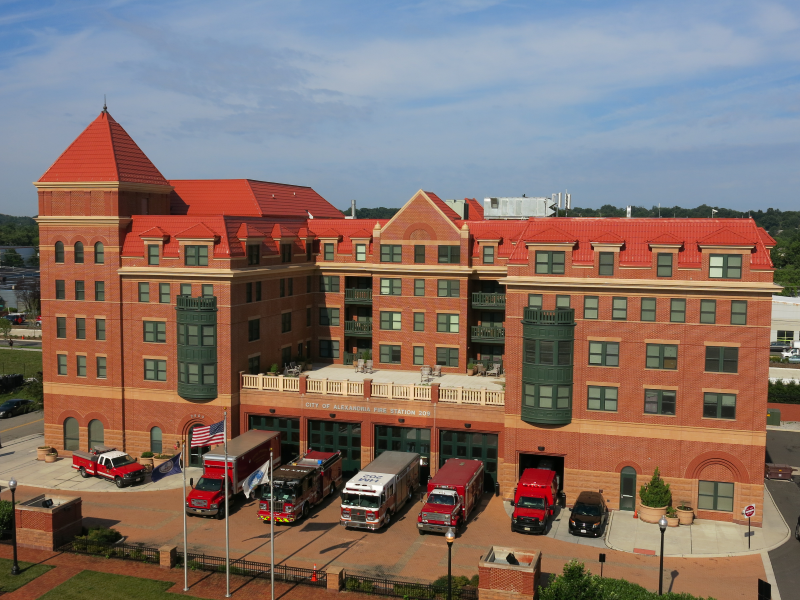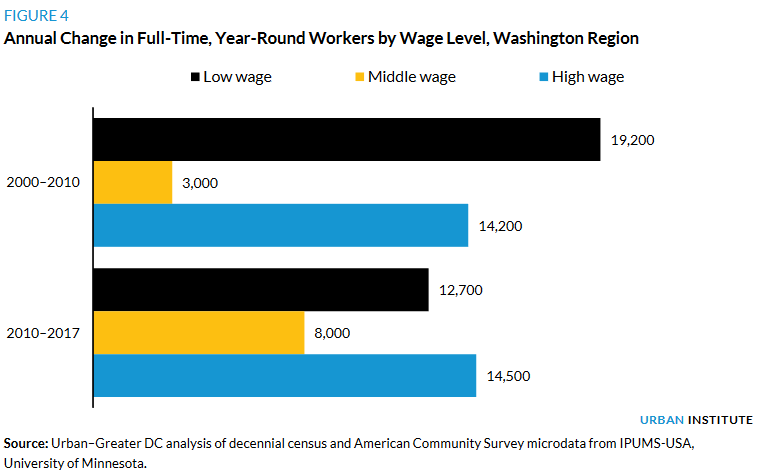To fix transit-oriented development’s displacement problem, use every tool available

Alexandria built affordable housing over a fire station, known as The Station at Potomac Yard, along a bus route. Image by City of Alexandria.
This article is part of a limited series exploring the history, current policies, and initiatives to create and maintain equitable transit-oriented development in the region. The complete series will be available here. And then learn more by tuning into the series’ companion webinar, moderated by George Kevin Jordan, GGWash’s editor-in-chief.
It is clear that transit-oriented development holds a host of benefits for the Washington region and the people who call it home — many of whom want to live in communities that are walkable and dense, and thus don’t require car ownership. It’s also clear, however, that TOD hasn’t always been equitable in impact. Speculation on its added value has pushed rent prices up around these developments and, by consequence, long-term and low-income residents out.
It’s a pattern that happens so quickly, according to Stewart Schwartz, the executive director of Coalition for Smarter Growth, that even by the time such a development is an idea, it can almost be too late to salvage affordability.
“Because the market sees such value in transit and transit-oriented development, that almost the second a jurisdiction starts talking about a new transit corridor, and the new small area plan or sector plan to go with it, you can see land speculation start to happen,” he said.
The region is focused on increasing its stock of transit-oriented developments to ease its housing shortages and to grow in an environmentally conscious way. WMATA has been working since the 1970s to deliver 55 joint housing projects at 30 metro stations, and plans to accelerate TOD efforts in the coming years. However, 20,000 Black residents have also been displaced from DC between 2000 and 2013, and there are still thousands in the region without stable housing.
From the 2019 Meeting the Washington Region’s
Future Housing Needs report. Image by Urban Institute.
According to a 2019 Urban Institute report, the Washington region’s supply of low-cost housing units is short by 264,000 units. Allowing for more density in areas zoned for single-family homes is a key part of the increasing housing stock overall, but if the region is to succeed in both protecting existing residents and making room for new ones, it must pull out all the stops to make resulting developments equitable.
Challenges in local efforts to foster affordable housing
DC has a variety of initiatives that, by many measures, make it a national leader in affordable housing, including its progressive inclusionary zoning policies, which allows more housing to be built, and its Housing Production Trust Fund (HPTF), which aims to build and preserve affordable housing, particularly near transit.
Mayor Muriel Bowser has committed to dedicating $100 million annually to the fund, and it received a boost recently when DC directed $530 million of federal COVID-19 relief money to affordable housing. At least 40% of HPTF funds must assist production of housing units for families below 30% of the AMI, 40% for those between 31-50% of the AMI, and the remaining funds are for those earning up to 80% of the AMI.
The majority of DC’s affordable housing efforts aren’t attainable for its poorest residents, according to a 2019 paper by the Coalition for Smarter Growth. The bulk are aimed at households at 50-80% of the average median income, but the greatest need for housing is amongst much lower income residents — the city’s janitors, home health aides, and servers who make, on average, well under $30,000 a year, putting them below 30% of the average median income.
From the 2019 Meeting the Washington Region’s
Future Housing Needs report.
However, a 2021 audit from the DC Office of the Inspector General found that HPTF had failed in its legally mandated directive to put at least half of the trust’s funds to extremely low-income housing (30% or less of the area’s AMI), and had put just 27% there in 2021.
Supporters say the HPTF is a vital way to bridge the financing needs to construct affordable units, and point to the fact that it has created and preserved 9,000 of them since 2015. Critics of HPTF say that it functions largely as a way to subsidize lucrative projects for developers, only some of which end up benefiting low-income Washingtonians.
Many experts say financial investment in the fund must increase and that it must also change how “affordable” is defined so that it better serves the city’s poorest residents. Moreover, communities should have more input and control in how housing is built and managed.
Green New Deal for housing
Ward 4 Councilmember Janeese Lewis George believes the answer is social housing — homes that are publicly owned and mixed-income. Without the need to satisfy a profit incentive, Lewis George says that funds can be invested directly in keeping housing affordable long term.
“Social housing puts the profits and power in the hands of people,” said Lewis George, who introduced the Green New Deal for Housing Act in April. “Through social housing, working class people in DC will be able to benefit from access to public transit directly in front of their doorstep and rents they can actually afford.”
The act would establish a new office to oversee the construction of net-zero-emissions housing, which would have minimal parking and be close to public transportation. About a third would go to extremely low income Washingtonians (less than 30% of AMI), a third to very low income residents (30-50% AMI), and the last third would be market rate to subsidize the other categories. Tenant leadership boards would make decisions about everything from property management to community rules. She also envisions it surrounded with childcare centers, grocery stores, and other unionized local businesses.
While social housing has failed to gain traction in the District in the past, Lewis George points out that the pandemic was radicalizing for many. She believes that the housing crisis is reaching a breaking point and many District residents are primed to reconsider such a model. Maryland has seen a multi-year effort to pass social housing legislation which, while still unrealized, has garnered significant levels of support for financing the construction of thousands of state-owned, mixed-income units every year. (The legislation was paired with the Planning for Modest Homes Act,” which aimed to further denser housing developments near public transportation.)
Community land trusts
Another local effort to maintain affordable housing is the Douglass Community Land Trust, a nonprofit that acquires land and keeps it in a trust so that the housing built on it remains affordable for low-income residents permanently.
“We are an anti-displacement organization, so our whole goal is to make sure that residents and small businesses of DC have a right to remain and thrive in DC,” said Vaughn Perry, the board president of the Douglass Community Land Trust.
Perry said that having decision-making power “reside directly within the community” is crucial to the model. The CLT is a membership organization that votes in a board of directors composed of one-third community residents, a third of people who live on the trust’s land, and a third who are subject matter experts.
“Community land trusts were birthed out of the civil rights movement. It is a vehicle that centers racial and economic equity, and one of the main ways we do that is through the community control that is undergirded in a community land trust,” Perry said. The goal is to provide housing “not just for this current generation but, just as importantly, for generations to come.”
The Douglass Community Land Trust’s first investment in 2019 was the 65-unit Savannah Apartments, which is located near the Congress Heights Metro station.
CLTs exist all over the country, including locally in Baltimore and Richmond. More recently, several towns in Northern Virginia considered experimenting with them to help mitigate the state’s housing crises. Perry said the city could help these efforts by considering the trust when offloading excess properties, or favoring developers who partner with the CLT.
On October 12, 2022, GGWash hosted a webinar, moderated by George Kevin Jordan, GGWash’s editor-in-chief, based on this story series. Watch the recording to learn more about the topics raised in this article.
Housing partnered with public services
Another affordable housing trend in the Washington region is to build homes in conjunction with public services, which are often community centers already adjacent to public transportation. Examples include the city of Alexandria’s new fire station with 64 housing units, many of them affordable, and the recent successful push to include affordable housing in the remodel of the Chevy Chase Library.
Some area churches have also supported efforts to address the affordable housing deficit. The First Baptist Church in Clarendon built 70 units of affordable housing — located just a block from the metro station — when remodeling its property. Just last month, the Fairlington Presbyterian Church in Alexandria opened the doors on its redevelopment of an underused parking lot into affordable housing.
The Church at Clarendon, formerly known as the First Baptist Church of Clarendon, got generous offers for its land. Instead, church leaders decided to build 70 dedicated units of affordable housing themselves. Image licensed under Creative Commons.
Experts say that there isn’t a single strategy that will get DC out of its longstanding housing crisis — after all, DC has some of the country’s worst gaps in housing affordability. According to a National Low Income Housing Coalition’s Housing Wage, a resident would have to work 78 hours a week at the $15.20 minimum wage to afford the average $1,548 cost of a modest one-bedroom.
Instead, the region must take seriously a variety of strategies to create dense, low-emissions communities that serve the area’s residents not just in name, but in practice.
“I think the bottom line is the most sustainable and equitable way, in our view, to grow is through a network of inclusive, transit-oriented communities. And we have to use all possible tools to get there,” Schwartz said.
This article is part of a limited series exploring equitable transit-oriented development, made possible with a grant from Amazon. Greater Greater Washington’s editorial department maintains editorial control and independence in accordance with our editorial policy. Our journalists follow the ethics guidelines of the Society of Professional Journalists.
